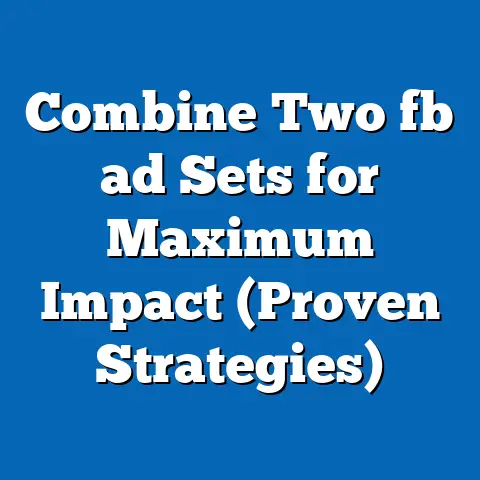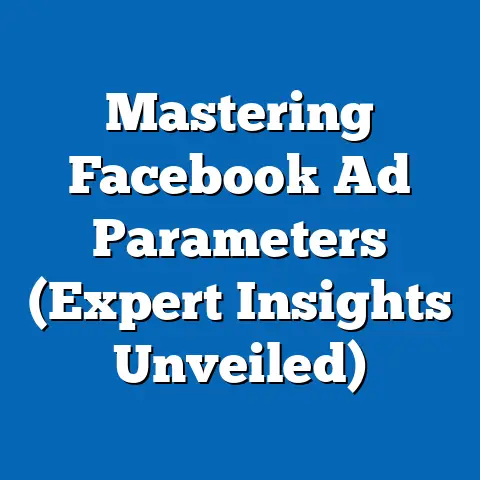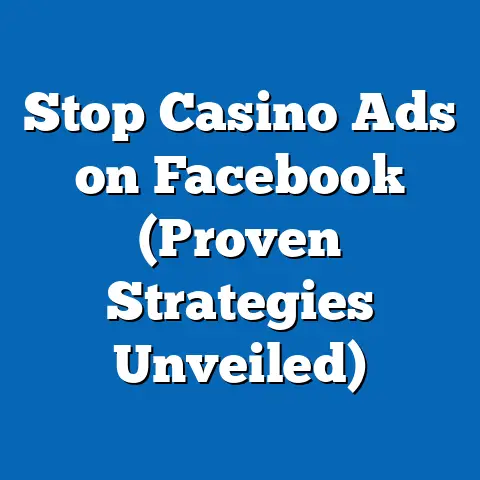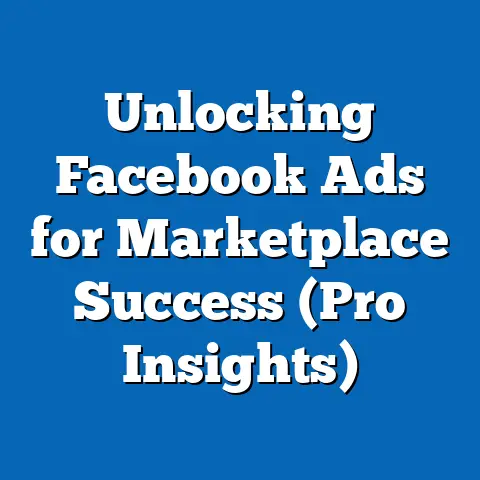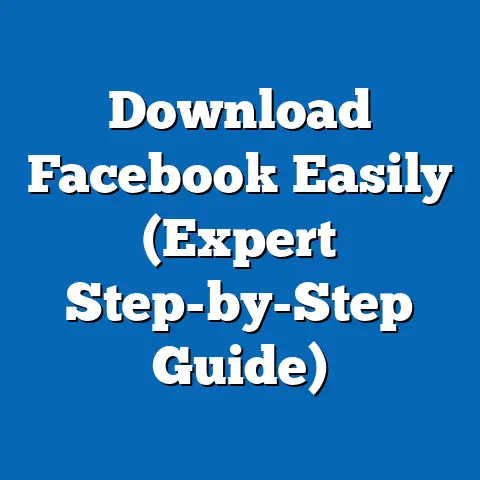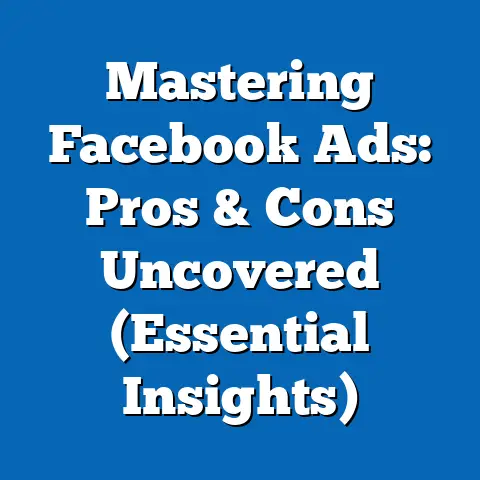Mastering Ad Control on Facebook (Expert Guide Inside)
Imagine you have allergies. You’re constantly trying to figure out what’s triggering those annoying symptoms – the itchy eyes, the sneezing, the overall discomfort. It’s a process of elimination, careful observation, and constant adjustment. Facebook advertising can feel a lot like that! You’re trying to reach the right people, with the right message, at the right time, and avoid those “allergic reactions” – wasted ad spend and poor results. Just as understanding your allergens is crucial for a healthy life, mastering ad control on Facebook is essential for a thriving business. I’ve spent years navigating the complexities of Facebook’s advertising platform, and I’m here to share my insights on how you can take control of your campaigns and achieve the results you’re looking for. This guide will walk you through everything from understanding the Facebook ecosystem to crafting the perfect ad strategy, mastering ad control settings, and navigating the challenges that come with it. Think of me as your friendly, experienced guide to conquering the world of Facebook Ads.
Understanding Facebook’s Advertising Ecosystem
Facebook, with its billions of active users, offers an unparalleled opportunity for businesses to connect with their target audience. It’s like having a massive stage where you can showcase your product or service to the world. But just like any stage, you need to know how to work it effectively.
The Reach and Capabilities: Facebook’s advertising platform is incredibly powerful because of its sheer reach. Millions of people log in every day, providing a constant stream of potential customers. This massive audience, combined with sophisticated targeting options, allows you to pinpoint exactly who you want to see your ads.
The Power of Targeting: One of the biggest advantages of Facebook Ads is its granular targeting. You can target people based on a wide range of factors:
- Demographics: Age, gender, location, education, job title, and more.
- Interests: Hobbies, passions, and pages they like.
- Behaviors: Past purchases, device usage, travel habits, and other online activities.
- Custom Audiences: Upload your own customer lists or create lookalike audiences based on your existing customers.
I remember working with a local bakery that wanted to increase its cake orders. Instead of simply running a generic ad, we used Facebook’s targeting to reach people in their area who had recently engaged with wedding-related content or expressed an interest in baking. The result? A significant increase in cake orders and a much higher return on investment.
The Central Hub: Facebook Ads Manager: The Facebook Ads Manager is where all the magic happens. It’s your control panel for creating, managing, and analyzing your campaigns. Think of it as the cockpit of your advertising airplane. From here, you can:
- Create new campaigns and ad sets.
- Design your ads and choose your ad formats.
- Set your budget and schedule.
- Track your results and make adjustments.
The Algorithm’s Influence: Facebook’s algorithm plays a crucial role in determining which ads are shown to which users. Understanding how the algorithm works is key to optimizing your campaigns. It considers factors like:
- Ad Relevance: How relevant your ad is to the target audience.
- Bid Amount: How much you’re willing to pay for each click or impression.
- Estimated Action Rates: The likelihood that users will take the desired action (e.g., click, purchase, sign up).
- Ad Quality: The overall quality of your ad, including its visual appeal and messaging.
The key takeaway here is that Facebook’s advertising ecosystem is a complex but powerful tool. By understanding its reach, targeting options, Ads Manager, and algorithm, you can position yourself for success.
Next Steps: * Familiarize yourself with the Facebook Ads Manager interface. * Explore the different targeting options available. * Start brainstorming potential target audiences for your business.
Crafting the Perfect Ad Strategy
Creating a successful Facebook ad strategy is like building a house. You need a solid foundation, a clear blueprint, and the right materials to ensure it stands strong.
Setting Clear Objectives and KPIs: Before you even create your first ad, you need to define your objectives. What do you want to achieve with your Facebook advertising? Common objectives include:
- Brand Awareness: Increasing the visibility of your brand.
- Lead Generation: Collecting contact information from potential customers.
- Website Traffic: Driving traffic to your website.
- Conversions: Generating sales, sign-ups, or other desired actions.
Once you’ve defined your objectives, you need to identify your Key Performance Indicators (KPIs). These are the metrics you’ll use to measure your progress. Examples of KPIs include:
- Reach: The number of unique people who saw your ad.
- Impressions: The number of times your ad was displayed.
- Click-Through Rate (CTR): The percentage of people who clicked on your ad.
- Cost Per Click (CPC): The average cost you paid for each click.
- Conversion Rate: The percentage of people who took the desired action after clicking on your ad.
- Return on Ad Spend (ROAS): The amount of revenue you generated for every dollar you spent on advertising.
I once worked with a small e-commerce business that was struggling to generate sales. They were running Facebook ads, but they weren’t seeing any results. After analyzing their campaigns, I realized they hadn’t defined clear objectives or KPIs. They were simply throwing money at Facebook and hoping for the best. We worked together to define their objectives (increasing sales) and KPIs (ROAS). By tracking these metrics, we were able to identify which ads were performing well and which were not, allowing us to optimize their campaigns and significantly improve their ROAS.
The Importance of Audience Research and Segmentation: Understanding your target audience is crucial for creating effective ads. You need to know who they are, what they’re interested in, and what motivates them. This is where audience research and segmentation come in.
- Audience Research: Use Facebook Audience Insights to gather data about your potential customers. This tool provides valuable information about their demographics, interests, behaviors, and more.
- Audience Segmentation: Divide your target audience into smaller groups based on shared characteristics. This allows you to create more targeted ads that resonate with each segment.
For example, if you’re selling fitness products, you might segment your audience based on their fitness goals (e.g., weight loss, muscle gain, endurance training). You can then create ads that specifically address the needs and interests of each segment.
Creating Compelling Ad Copy and Visuals: Your ad copy and visuals are what will grab people’s attention and persuade them to take action. Here are some tips for creating compelling ads:
- Use clear and concise language: Get straight to the point and avoid jargon.
- Highlight the benefits, not just the features: Focus on how your product or service will improve people’s lives.
- Use strong visuals: Choose high-quality images or videos that are relevant to your target audience.
- Include a clear call to action: Tell people what you want them to do (e.g., “Shop Now,” “Learn More,” “Sign Up”).
I’ve found that using customer testimonials and user-generated content can be incredibly effective in building trust and credibility. Showing real people enjoying your product or service can be much more persuasive than simply making claims about its benefits.
Next Steps: * Define your objectives and KPIs for your Facebook advertising campaigns. * Conduct thorough audience research using Facebook Audience Insights. * Brainstorm creative ad copy and visuals that will resonate with your target audience.
Mastering Ad Control Settings
Now that you have a solid ad strategy in place, it’s time to dive into the nitty-gritty of ad control settings. This is where you’ll fine-tune your campaigns to maximize your results.
Budget Management: Setting the right budget is crucial for ensuring your ads are seen by enough people without breaking the bank. Facebook offers two main budgeting options:
- Daily Budget: Set a fixed amount you’re willing to spend each day.
- Lifetime Budget: Set a total amount you’re willing to spend over the entire duration of your campaign.
I typically recommend starting with a daily budget, as it allows you to monitor your performance and make adjustments more frequently. You can always increase your budget later if your ads are performing well.
Scheduling: Scheduling allows you to control when your ads are shown to your target audience. You can choose to run your ads continuously or set specific start and end dates. You can also schedule your ads to run only during certain hours or days of the week.
For example, if you’re running ads for a restaurant, you might schedule them to run during lunchtime and dinner hours, when people are more likely to be thinking about food.
Placement Options: Facebook offers a variety of placement options for your ads, including:
- Facebook Feed: The main news feed on Facebook.
- Instagram Feed: The main news feed on Instagram.
- Facebook Stories: Short-form video content on Facebook.
- Instagram Stories: Short-form video content on Instagram.
- Facebook Marketplace: A platform for buying and selling goods on Facebook.
- Audience Network: A network of third-party websites and apps that display Facebook ads.
I recommend testing different placement options to see which ones perform best for your target audience. You can use Facebook’s Automatic Placements option to let the algorithm optimize your placements for you.
A/B Testing for Optimization: A/B testing, also known as split testing, is a powerful technique for optimizing your ad performance. It involves creating two or more versions of your ad and testing them against each other to see which one performs best.
You can A/B test different elements of your ad, such as:
Tracking Metrics and Refining: Tracking your metrics is essential for assessing the effectiveness of your ads. Pay close attention to the following metrics:
- CTR: A high CTR indicates that your ad is relevant and engaging.
- CPC: A low CPC indicates that you’re getting good value for your money.
- Conversion Rate: A high conversion rate indicates that your ad is effectively driving the desired action.
Based on your metrics, you can refine your targeting, adjust your budgets, and make other changes to improve your ad performance.
I once helped a client who was struggling with a low conversion rate. After analyzing their data, I noticed that their ads were generating a lot of clicks, but very few people were actually making a purchase. I realized that their landing page was not optimized for conversions. We worked together to redesign their landing page, making it more user-friendly and persuasive. As a result, their conversion rate increased significantly.
Next Steps: * Experiment with different budget management options. * Explore the various scheduling and placement options available. * Set up A/B tests to optimize your ad performance. * Track your metrics and make adjustments based on your data.
Navigating Challenges and Compliance
Facebook advertising isn’t always smooth sailing. You’ll inevitably encounter challenges along the way. It’s important to be prepared to navigate these challenges and ensure you’re complying with Facebook’s advertising policies.
Ad Rejection and Account Suspension: One of the most frustrating challenges is having your ad rejected or your account suspended. This can happen for a variety of reasons, such as:
- Violating Facebook’s advertising policies: This includes promoting prohibited content, making misleading claims, or using deceptive tactics.
- Having a low ad quality score: Facebook penalizes ads that are not relevant or engaging.
- Receiving negative feedback from users: If people are reporting your ads as spam or hiding them from their feeds, Facebook may suspend your account.
If your ad is rejected or your account is suspended, don’t panic. Carefully review Facebook’s advertising policies and make sure your ads are in compliance. You can also appeal the decision by contacting Facebook’s support team.
Facebook’s Advertising Policies and Guidelines: It’s crucial to familiarize yourself with Facebook’s advertising policies and guidelines. These policies cover a wide range of topics, including:
- Prohibited Content: Content that is not allowed on Facebook, such as hate speech, violence, and illegal activities.
- Restricted Content: Content that is allowed on Facebook, but with certain restrictions, such as alcohol, gambling, and political advertising.
- Personal Attributes: You cannot target people based on their personal attributes, such as race, ethnicity, religion, or sexual orientation.
- Misleading Claims: You cannot make false or misleading claims about your product or service.
Ensuring Ad Content Adheres to Community Standards: In addition to complying with Facebook’s advertising policies, you also need to ensure your ad content adheres to Facebook’s Community Standards. These standards cover a wide range of topics, including:
- Safety: Protecting people from harm and violence.
- Privacy: Protecting people’s personal information.
- Authenticity: Ensuring that content is genuine and not misleading.
- Respect: Treating people with respect and dignity.
Dealing with Ad Fatigue: Ad fatigue occurs when your target audience becomes tired of seeing the same ads over and over again. This can lead to a decrease in engagement and a decline in performance.
To combat ad fatigue, you can:
- Rotate your ads: Create new ads on a regular basis to keep things fresh.
- Refine your targeting: Narrow your target audience to focus on the people who are most likely to be interested in your ads.
- Use different ad formats: Experiment with different ad formats, such as images, videos, and carousel ads.
- Pause your ads: If your ads are experiencing ad fatigue, pause them for a few days or weeks to give your target audience a break.
I’ve learned that constantly monitoring your ad performance and being proactive in addressing potential issues is key to long-term success on Facebook. Don’t be afraid to experiment and try new things, but always be mindful of Facebook’s policies and guidelines.
Next Steps: * Review Facebook’s advertising policies and guidelines. * Ensure your ad content adheres to Facebook’s Community Standards. * Develop a strategy for dealing with ad fatigue.
Conclusion
Mastering ad control on Facebook is an ongoing journey, much like effectively managing allergies. It requires continuous learning, adaptation, and a willingness to experiment. By understanding the Facebook advertising ecosystem, crafting a perfect ad strategy, mastering ad control settings, and navigating challenges and compliance, you can take control of your campaigns and achieve the results you’re looking for. Don’t be afraid to dive in, test different approaches, and learn from your mistakes. With dedication and persistence, you can unlock the full potential of Facebook advertising and drive significant growth for your business.
Call to Action
Now it’s your turn! What are your biggest challenges with Facebook ads? Share your experiences and insights in the comments below. And don’t forget to subscribe to my newsletter for more expert tips and strategies on navigating the ever-evolving landscape of digital marketing. Let’s conquer the world of Facebook ads together!

